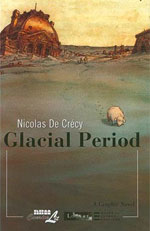 by Nicolas De Crecy
by Nicolas De Crecyreviewed by Eraklis Petmezas
The first time I saw Nicolas De Crecy’s work was when one of my best friends came back from a European trip in the early 90’s with sketch books he had purchased of a new young French cartoonist. Flipping through them I was mesmerized by such a strong vision. De Crecy’s characters were both realistic and stylized in the same line. This was an artist that was closer to Egon Schiele than his contemporary brethren. The way he drew figures really showed you a glimpse of who they were. Most artists search years to find what De Crecy had found in his early twenties.
It was shortly after that an issue of Heavy Metal (March 1992) translated "Foligatto". I was finally able to read a Nicolas De Crecy story. His art translated amazingly well into the sequential form. His colors were beautiful. They created the mood of the story and dragged you into it. He put as much detail into the backgrounds as he did his people. He gave you a sense of the world around them. In turn it drew you deeper into his art. It’s no wonder that years later his work would inspire the wonderfully unique animated film Triplets of Belleville.
When I found out that the Parisian museum The Louvre picked four cartoonists to create comics based on the museum and its work I was impressed. I thought it was nice to see such an esteemed establishment recognize comics as an art form that could elevate awareness of the museum itself. I was elated to read that Nicolas De Crecy was one of those artists chosen.
Glacial Period takes place thousands of years into the future. The earth is covered in snow and ice. This is a future where dogs have been bioengineered to have thoughts and emotions that parallel humans. A group of archeologists are trying to uncover any thing that can give them some insight into the past. Even here on a barren earth we still find the males in the expedition arguing over whose name will go first in what ever discoveries they may find.
When a shift in the ice uncovers the hidden Louvre we get to see the expedition turn from an expedition into the past to a psychological journey. As they look at the centuries old paintings it’s comical to watch them try to decipher what is depicted on the canvas. Most of them are nudes and the men in the group automatically think that the women of the past must have had loose morals to constantly be without clothes. They conclude that humanity must not have had a written language since all they find are paintings. In another part of the museum the statues come to life to tell the story of what happened to our civilization.
Glacial Period is at times satire, and other times a biting commentary of our world. Nicolas De Crecy has crafted a story worthy of the respect of The Louvre, as well as any lover of the sequential form. This painted story creates a world that stays with you long after you put the book down. I applaud NBM for translating this work. I hope it won’t be another decade before we can read more work by Nicolas De Crecy. I highly recommend this book.


7 comments:
Thanx for the tip Herc! Sounds like a goodern'!
No problem. I have more coming.:-)
peace,
Herc
Oh, and thanks for commenting. :-)
I was feeling lonely. hahaha
peace,
Herc
No prob, Homie! see ya in tha store!
R-
I didn't know his work inspired Triplets of Belleville. That was a good movie.
I still want to see that...looked very different.
and different is good!
WOW!! Please put a copy in my bin-- and this is just another reason why you guys should have a small, but vital video section. I would buy this book and the Triplets video at the same time, but then again I am a freak of sorts.
Post a Comment